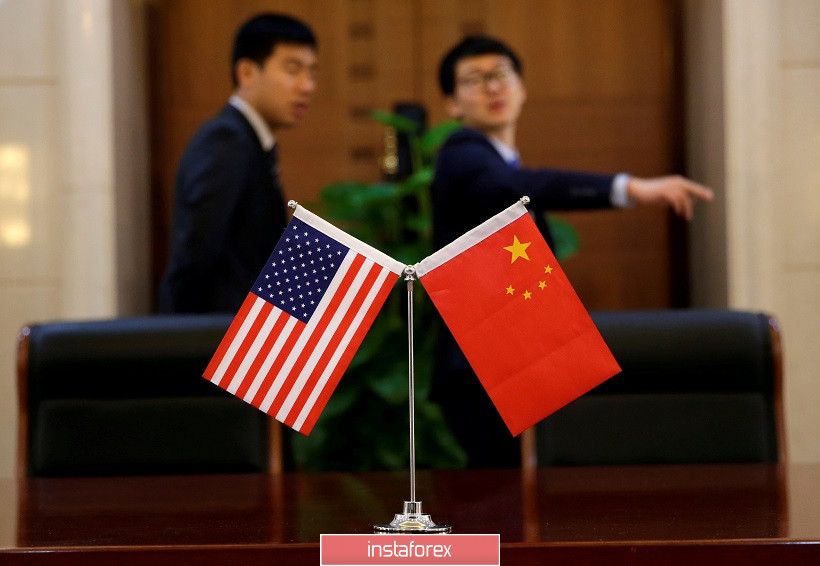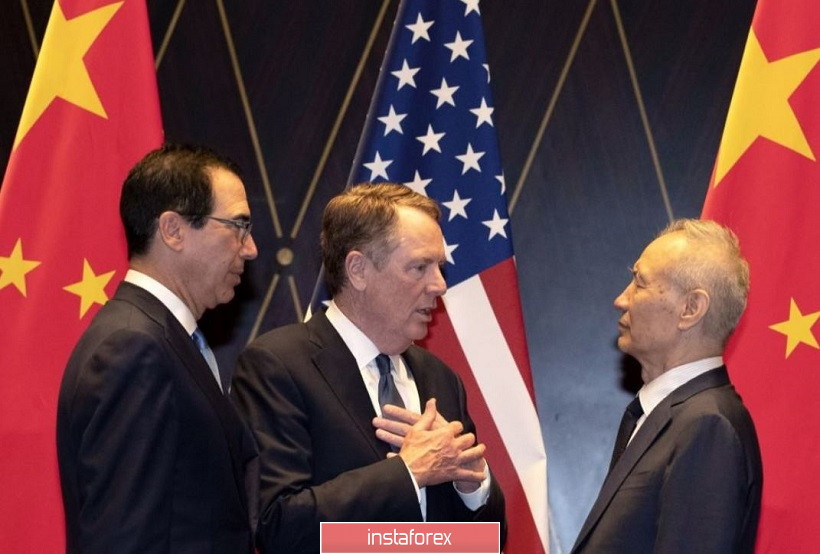The euro-dollar pair demonstrates quite a large-scale correctional growth today: for the first time since the end of September, buyers were able to gain a foothold within the 10th figure, thereby updating the three-week price high. It is worth mentioning right away that this price movement is impulsive and emotional in nature, so it is absolutely impossible to trust the growth of EUR/USD now. Moreover, the pair's price growth is not due to the appreciation of the euro, but to the temporary weakness of the dollar amid conflicting rumors about the course of the negotiation process between Washington and Beijing.

The current situation in the foreign exchange market eloquently reflects the dynamics of the dollar-yen pair. In the morning, rumors began to appear in the news tapes that there was no progress in the negotiations and the Chinese delegation would leave the US capital ahead of schedule. The Japanese currency instantly reacted, plunging by several dozen of points to the bottom of the 107th figure. But then the opposite information appeared on the market, after which the pair updated the daily high.
The European currency in this case acts as the beneficiary of the general confusion. The market receives fragmentary information, which currently fuels interest in risky assets. But the situation may change at any moment, so before the end of trade negotiations it is better to refrain from opening any positions - both for the EUR/USD pair and for the rest of the pairs.
If we summarize all the information that is currently available, we can distinguish several most likely scenarios. The first is the complete failure of the negotiation process. According to the Chinese press, the preliminary consultations, which lasted two days before the start of the main talks, ended in nothing: the Chinese refused to fulfill one of the key requirements of the Americans (regarding the forced transfer of technology), and US representatives refused to discuss the possibility of freezing the increase in duties. This issue, in turn, was the main priority for China.
Also in favor of the negative scenario are the comments of US Secretary of Commerce Wilbur Ross, who, a few hours before the start of negotiations, criticized Beijing for "unconstructive behavior." In addition, the day before the arrival of the Chinese delegation, the White House expanded the sanctions list to include 28 Chinese organizations - according to officials, they were involved in violating the rights of Uyghurs in Xinjiang province. The "black list" includes government agencies and technology companies specializing in the production of video surveillance equipment.
Thus, amid the toughening positions of the parties, as well as the results of failed preliminary consultations, the market made a fairly reasonable assumption that the 13th round of negotiations will end in the same way as the previous 12. This means that on October 15, US duties on Chinese $250 billion worth of goods will rise from 25% to 30%, and from December 15, the United States will introduce additional duties on a separate list of goods. In this case, the Federal Reserve will guaranteedly reduce the interest rate by 25 points by the end of the year (according to other analysts, the regulator will reduce the rate twice, both in November and December).
But during the negotiations at a "high" level, encouraging information also appeared. According to an insider of US journalists, the parties may conclude a currency agreement this week, which will become part (the first stage) of the "big deal". The main advantage of this option is that in this case, the White House may delay the introduction of the above fees, and the parties will continue negotiations on the remaining points of a possible deal. According to various sources, not everyone in the White House is ready to support this idea. In particular, the US trade representative Lighthizer takes a tough stance: he has repeatedly stated that until consensus is reached on all key issues, Washington will not oblige itself with any kind of agreement. In turn, US Treasury Secretary Stephen Mnuchin advocates a softer stance on China - apparently, he is the main lobbyist for the conclusion of the "limited deal." Whose side Donald Trump will eventually take is still unknown. Therefore, the intrigue in this issue remains, and the unexpected denouement of this plot can completely "redraw" the fundamental picture for dollar pairs.

It is worth noting that the dollar has weakened today not only against the backdrop of uncertainty around the negotiation process. US inflation also added fuel to the fire. The published CPI has indeed been very weak. The overall monthly index unexpectedly slowed to zero, contrary to growth forecasts to 0.1%. In annual terms, the CPI remained in place: in September, the indicator reached 2.4% y/y, although economists had expected growth to 2.5%.
Core inflation was also disappointing. The core index, excluding food and energy prices, fell more than expected. In monthly terms, the index reached 0.1% last month, although analysts predicted more substantial growth. Slowing core inflation is an alarming sign, especially amid slowing wage growth. Let me remind you that the inflationary component of Nonfarms also disappointed the market, being in the "red zone". Now the negative picture has been supplemented by today's release.
Thus, given the ambiguity of the situation, it is best for traders of the EUR/USD pair to take a wait-and-see attitude. Tomorrow we will find out the denouement of this "thriller", which may turn out to be very unexpected.
 English
English 
 Русский
Русский Bahasa Indonesia
Bahasa Indonesia Bahasa Malay
Bahasa Malay ไทย
ไทย Español
Español Deutsch
Deutsch Български
Български Français
Français Tiếng Việt
Tiếng Việt 中文
中文 বাংলা
বাংলা हिन्दी
हिन्दी Čeština
Čeština Українська
Українська Română
Română

